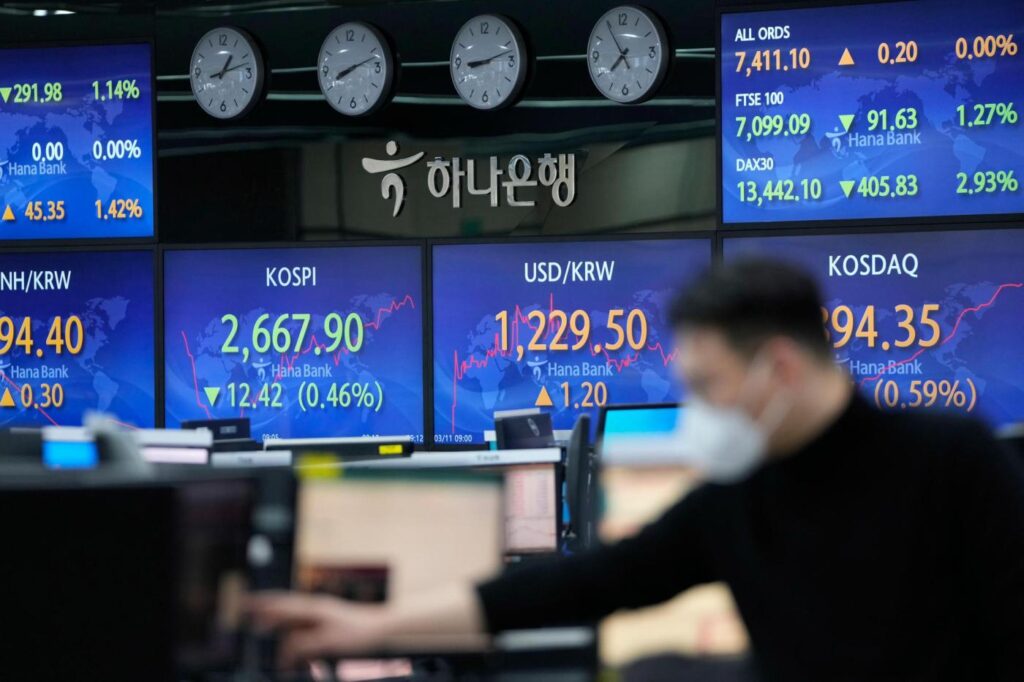
NEW YORK (AP) — U.S. markets headed for a higher open Friday following solid gains in Europe as uncertainty over the war in Ukraine and persistently high inflation continue to roil markets. Asian markets declined overnight.
Investors are fretting over a world economy faced with price pressures and slowing growth. Oil prices advanced on Friday as Russian forces broadened their offensive in Ukraine, attacking two major cities to the west and an industrial center in the east of the country.
On Wall Street, futures for the Dow Jones Industrial Average rose 1.1% Friday morning and the same for the S&P 500 were up 1.3%.
Germany’s DAX rose 3.2% by midday, the CAC 40 in Paris added 2.2% and London’s FTSE 100 gained 1.4%.
A plan to revoke Russia’s most favored nation trade status over its invasion of Ukraine added to unease over the economic repercussions of the deepening conflict after talks between foreign ministers of the two countries failed to show any concrete progress.
President Joe Biden plans to announce the change Friday, according to a source familiar with the matter who spoke on the condition of anonymity to preview the announcement. It will allow the U.S. and other major industrial countries to raise tariffs on some Russian exports.
The move may have only a modest impact on trade, since it will have a negligible effect on most exports of oil, gas and other Russian resources, experts said.
Investors were keeping to the sidelines ahead of the weekend, given the potential for big surprises while markets are closed, analysts said.
“When confidence is low, risk managers are in the drivers’ seat, keeping bank and market maker liquidity to a minimum which could be exacerbating inter-day moves,” Stephen Innes of API Asset Management said in a commentary.
“And no wonder as predicting day-to-day market actions is about as consistent as flipping a coin,” Innes said.
In Asian trading, Tokyo’s Nikkei 225 index lost 2.1% to 25,162.78 and the Hang Seng in Hong Kong shed 1.6% to 20,553.79.
The Shanghai Composite index reversed earlier losses, gaining 0.4% to 3,309.75 after Chinese Premier Li Keqiang, the country’s No. 2 leader, said the government hopes to generate as many as 13 million new jobs this year.
As China’s largely ceremonial legislature wrapped up its annual session, Li promised “pro-job policies” including tax and fee cuts totaling 2.5 trillion yuan ($400 billion) for businesses. Such measures are meant to counter a slowdown in growth, which fell to 4% over a year earlier in the final quarter of 2021, down from the full year’s 8.1% expansion.
Surging coronavirus cases in both the Chinese mainland and Hong Kong have have added to concerns dogging their markets.
The Kospi in Seoul declined 0.7% to 2,661.28. In Australia, the S&P/ASX 200 gave up 0.9% to 7,063.60.
Oil prices have moderated after wild swings earlier in the week. U.S. benchmark crude rose 52 cents to $106.54 per barrel in electronic trading on the New York Mercantile Exchange. It fell $2.68 Thursday to $106.02 per barrel.
Brent crude, the basis for international pricing, was up 66 cents to $109.99 per barrel in London.
Both it and U.S. benchmark crude are up more than 40% for 2022 so far, though they remain below the peaks they hit earlier this week, when U.S. oil briefly topped $130.
Oil’s back-and-forth moves are just some of the waves buffeting markets as volatility has become the norm since Russia’s invasion of Ukraine, which has added to worries about how high prices will go for oil, wheat and other commodities.
Investors already were on edge because high inflation is pushing central banks to raise interest rates for the first time since the pandemic began and halt programs launched to support the global economy.
A report Thursday showed U.S. consumer prices leaped 7.9% in February from a year earlier, the sharpest spike since 1982. The reading was largely within expectations and did not include the most recent surges for oil and gasoline prices. It also didn’t hit the 8% threshold that might trigger alarm.
The Federal Reserve is expected to raise its key short-term rate by a quarter of a percentage point next week, the first hike since 2018. Higher rates slow the economy, and the Fed is trying to raise them enough to tamp down inflation but not so much that it causes a recession.
In other trading, the yield on the 10-year Treasury, which tracks expectations for inflation and economic growth, wavered immediately after the inflation report’s release. It rose to 2% from 1.94% late Wednesday. Early Friday it was at 2.02%.
The U.S. dollar rose to 116.88 yen from 116.11 yen, hovering near its highest level against the Japanese currency in six years. The euro ticked up to $1.1016 from $1.0987.
